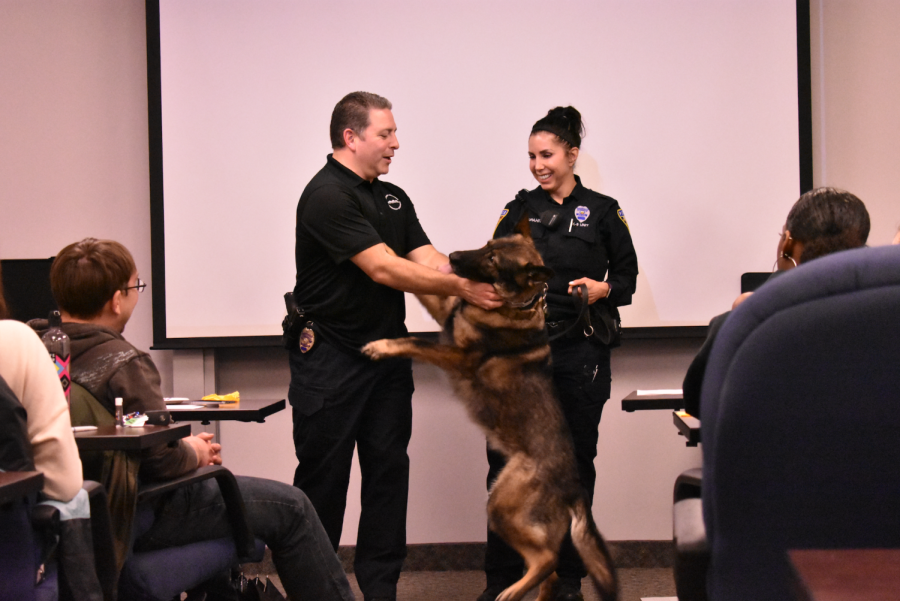Week three of KSUPD’S Police Experience Academy focuses on K-9 units
March 2, 2018
KSUPD’s Police Experience Academy entered week three Thursday, centered around K-9 units.
Officers Anne Spahr and Miguel Witt began their presentation by explaining how their jobs and duties as K-9 officers differs from those of other officers.
For example, they don’t wear pins or metal badges, opting for fabric emblems embroidered on their uniforms. This helps them better handle their K-9 partners.
K-9s are specifically bred for service. Spahr explained that when K-9s encounter other dogs, they tend to get aggressive. “It’s about dominance with them,” Spahr said.
KSUPD has two K-9 units: Coco, whose partner is Spahr, and Dexter, whose partner is Witt.
Coco is a 6-year-old German Shepherd from Von der Haus Gill, a K-9 training facility in Wapakoneta, Ohio. She’s been with the department since 2013, when she was certified in the State of Ohio, the Ohio Peace Officer Training Academy, the National Association of Police Canine handlers and the Bureau of Alcohol, Tobacco, Firearms and Explosives.
Coco was KSUPD’s first K-9 unit. The department adopted the program with the help of Spahr.
“She’s my partner, really”, Spahr said about Coco.
Dexter is a 4-year-old Belgian Malinois from the Netherlands. He was recruited by KSUPD using a grant from the Department of Homeland Security and was trained by Gold Shield Canine Training in Columbus in 2014.
Both dogs are trained as Explosive Detection Canines. As he was obtained through a Homeland Security grant, Dexter is considered a deployed asset from the federal government, while Coco is considered part of KSUPD. Both K-9s are based in Kent.
K-9 units are not cheap. They cost about $18,000 to train, depending on what they specialize in, and cruisers can cost upwards of $55,000 to be outfitted for K-9 duty. This includes a larger space in the back of the cruiser as well as a cage and precautions in case the car gets too hot.
“It’s hard to outsmart them,” Spahr said.
Training for K-9s can last up to 12 weeks, in which EDCs are taught how to correctly identify various odors and odor combinations commonly found in explosives. Dexter and Coco also underwent specialized training in rappelling, helicopter drills and other methods designed to heighten their abilities to detect different explosives. Officers train 5-6 weeks to work with and handle K-9 units.
“You walk in a house and smell stew cooking. The dogs walk in and can smell the beef, carrots and onions,” Witt said about their heightened sense of smell.
The officers also talked about their personal relationship with their K-9s.
K-9 units live with their officers and will almost always train with them. While most K-9s are rewarded with food or a treat during training, Dexter and Coco are rewarded with their very durable toys.
Coco’s toy is a piece of industrial firehose covered with duct tape. Dexter’s toy is a tube of hard plastic with Kevlar inside. When the K-9s retire from service, usually after 7-10 years, they will continue to live with their officer’s families.
“Our families are their pack,” Witt said.
David Williams is the safety reporter. Contact him at [email protected].

























